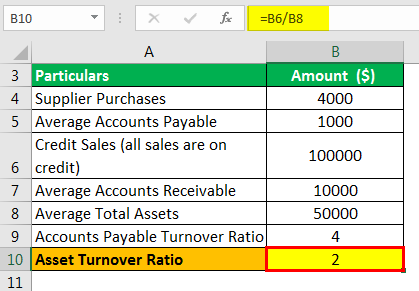
The average inventory value is calculated by adding the beginning and ending inventory values and dividing them by two.įor example, if your COGS for a year was $1 million, and your average inventory value was $200,000, then your Inventory Turnover Ratio would be 5 ($1 million divided by $200,000). COGS represents the cost of producing or purchasing goods that are sold during a specific period. To calculate the inventory turnover formula, divide the cost of goods sold (COGS) by the average inventory value. By knowing this metric, you can make informed decisions about managing your inventory levels and improving overall efficiency.
#AVERAGE ANNUAL TURNOVER FORMULA HOW TO#
How to Calculate the Inventory Turnover FormulaĬalculating the inventory turnover formula is crucial for understanding how efficiently your procurement process is operating. In essence, mastering this formula enables companies to gain crucial insights into their procurement process efficiency – enabling them to make data-driven decisions about optimizing stock levels, identifying slow-moving items, and improving overall operational performance.

A higher ratio indicates that your business is selling products quickly relative to its stock levels, while a lower ratio suggests slower movement and potential inefficiencies in managing your inventory. COGS refers to the direct costs incurred in producing or acquiring goods for sale, while average inventory represents an estimate of the value of goods held by a company over a specific time frame.īy dividing COGS by average inventory, you can calculate your annual inventory turnover rate. This metric helps businesses understand their sales velocity and determine how effectively they are utilizing their available stock.Ĭalculating this formula involves two key components: cost of goods sold (COGS) and average inventory. To put it simply, the inventory turnover rate calculates the number of times a company sells and replaces its average inventory within a given period. It provides valuable insights into the speed at which products move through the supply chain, from purchase to sale. The inventory turnover formula is a vital tool used in procurement to measure how efficiently a company manages its inventory.
#AVERAGE ANNUAL TURNOVER FORMULA PROFESSIONAL#
So, whether you’re an experienced procurement professional or just starting out on your journey towards operational excellence, buckle up as we embark on an insightful exploration of the annual inventory turnover formula and its immense potential in driving organizational success! What is the Inventory Turnover Formula?
:max_bytes(150000):strip_icc()/latex_83db900ac2992e3b4c3da3c0a5eece70-5c754f7446e0fb00018bd6eb.jpg)

But that’s not all – we’ll also uncover the benefits of maintaining a high inventory turnover rate and provide actionable steps to help you improve yours. From understanding the formula itself to calculating it accurately, we’ll guide you through each step. In this blog post, we will delve into the world of inventory turnover and explore how mastering the annual inventory turnover formula can revolutionize your procurement process. This formula provides valuable insights into how effectively a company manages its inventory, ensuring that products flow seamlessly from suppliers to customers. And at the heart of efficient procurement lies a key metric: the annual inventory turnover rate. Unlocking procurement efficiency is a top priority for businesses looking to streamline their operations and maximize profitability. Mastering the Annual Inventory Turnover Formula: A Key to Unlocking Procurement Efficiency


 0 kommentar(er)
0 kommentar(er)
